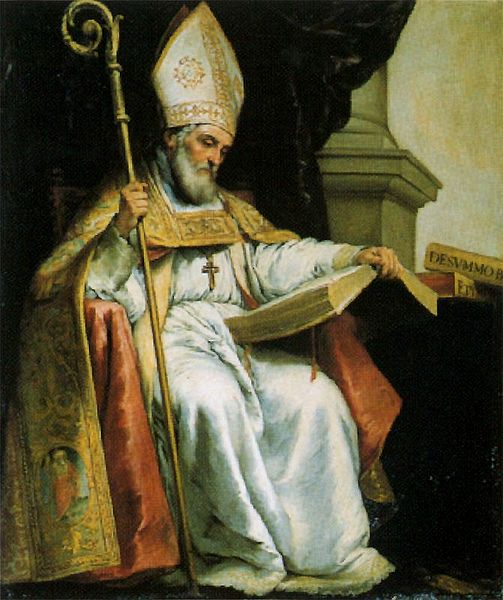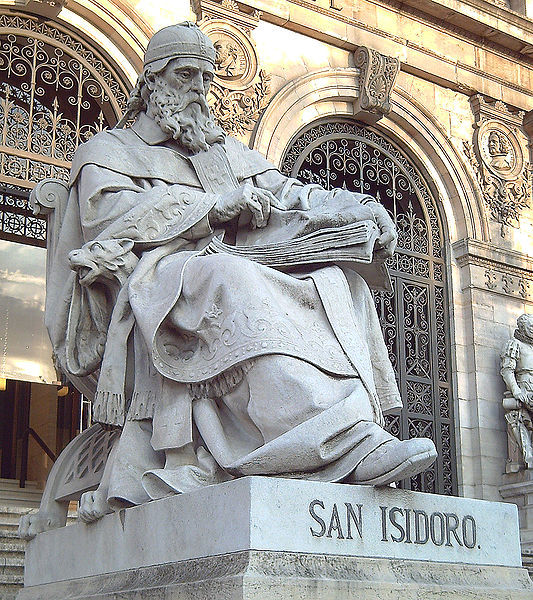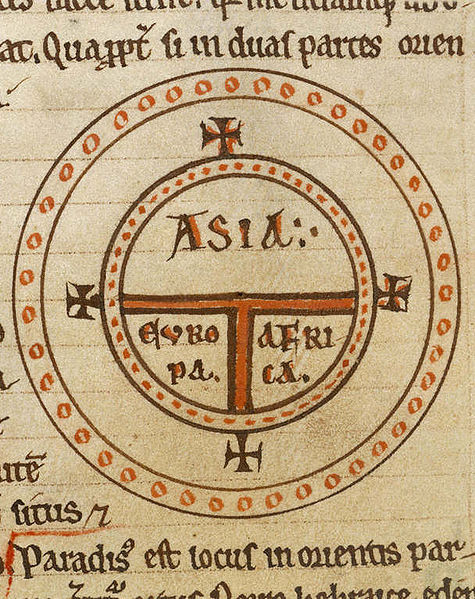<Back to Index>
- Archbishop and Historian San Isidro de Sevilla, 560
PAGE SPONSOR



Saint Isidore of Seville (Spanish: San Isidro or San Isidoro de Sevilla, Latin:Isidorus Hispalensis) (c. 560 – 4 April 636) served as Archbishop of Seville for more than three decades and is considered, as the historian Montalembert put it in an oft-quoted phrase, "le dernier savant du monde ancien" ("the last scholar of the ancient world"). Indeed, all the later medieval history writing of Hispania (modern Spain and Portugal) was based on his histories.
At a time of disintegration of classical culture and aristocratic violence and illiteracy, he was involved in the conversion of the royal Visigothic Arians to Catholicism, both assisting his brother Leander of Seville, and continuing after his brother's death. He was influential in the inner circle of Sisebut, Visigothic king of Hispania. Like Leander, he played a prominent role in the Councils of Toledo and
Seville. The Visigothic legislation which resulted from these councils
is regarded by modern historians as exercising an important influence on
the beginnings of representative government.
Isidore was born probably in Cartagena, Spain, to Severianus and Theodora, members of an influential family who were instrumental in the political - religious maneuvering that converted the Visigothic kings from Arianism to Catholicism. The Catholic Church celebrates him and all his siblings as known saints:
- An elder brother, Saint Leander of Seville immediately preceded Saint Isidore as Archbishop of Seville and, while in office, opposed king Liuvigild.
- A younger brother, Saint Fulgentius of Cartagena, served as the Bishop of Astigi at the start of the new reign of the Catholic King Reccared.
- His sister, Saint Florentina, served God as a nun and allegedly ruled over forty convents and one thousand consecrated religious. This claim seems unlikely, however, given the few functioning monastic institutions in Iberia during her lifetime.
Isidore received his elementary education in the Cathedral school of Seville. In this institution, the first of its kind in Iberia, a body of learned men including Archbishop Saint Leander of Seville taught the trivium and quadrivium, the classic liberal arts. Saint Isidore applied himself to study diligently enough that he quickly mastered at least a pedestrian level of Latin, a smattering of Greek and some Hebrew.
Two centuries of Gothic control of Iberia incrementally suppressed the ancient institutions, classic learning, and manners of the Roman Empire. The associated culture entered a period of long term decline. The ruling Visigoths nevertheless showed some respect for the outward trappings of Roman culture. The heresy of Arianism meanwhile took deep root among the Visigoths as the original form of Christianity that they received.
Scholars
may debate whether Isidore ever personally embraced monastic life or
affiliated with any religious order, but he undoubtedly esteemed the
monks highly.
After the death of Saint Leander of Seville on 13 March 600 or 601, Saint Isidore succeeded to the See of Seville. On his elevation to the episcopate, he immediately constituted himself as protector of monks.
Saint Isidore recognized that the spiritual and material welfare of the people of his See depended on assimilation of remnant Roman and ruling barbarian cultures; he consequently attempted to weld the peoples and subcultures of the Visigothic kingdom into a united nation. He used all available religious resources toward this end and succeeded completely. He practically eradicated the heresy of Arianism and completely stifled the new heresy of Acephali at its very outset. Archbishop Isidore strengthened religious discipline throughout his See.
Archbishop Isidore also used resources of education to counteract increasingly influential Gothic barbarism throughout his episcopal jurisdiction. His quickening spirit animated the educational movement centered on Seville. Saint Isidore introduced Aristotle to his countrymen long before the Arabs studied Greek philosophy extensively.
In
619, Saint Isidore of Seville pronounced anathema against any
ecclesiastic who in any way should molest the monasteries and children.
In great part due to the enlightened statecraft of his two brothers, the Councils of Seville and Toledo emanated Visigothic legislation; modern historians regard this legislation as exercising a most important influence on the beginnings of representative government.
Saint Isidore presided over the Second Council of Seville, begun on 13 November 619, in the reign of King Sisebut.
The bishops of Gaul and Narbonne and the Hispanic prelates all
attended. The Acts of the Council fully set forth the nature of Christ,
countering Arian conceptions.
All bishops of Hispania attended the Fourth National Council of Toledo, begun on 5 December 633. The aged Archbishop Saint Isidore presided over its deliberations and originated of most enactments of the council.
Saint Isidore used this opportunity to serve his country greatly. Through his influence, this Council of Toledo promulgated a decree, commanding all bishops to establish seminaries in their cathedral cities along the lines of the cathedral school at Seville, which educated Saint Isidore decades earlier. The decree prescribed the study of Greek, Hebrew, and the liberal arts and encouraged interest in law and medicine. The authority of the Council made this education policy obligatory upon all bishops of the Kingdom of the Visigoths.
The council probably expressed with tolerable accuracy the mind and influence of Isidore.
The council granted remarkable position and deference granted to the
king of the Visigoths. The free and independent Church bound itself in
solemn allegiance to the acknowledged king; it said nothing of
allegiance to the Bishop of Rome.
Saint Isidore attempted to compile a summa of universal knowledge. This encyclopedia epitomized all ancient and contemporary learning. It preserves many fragments of classical learning, otherwise hopelessly lost. The fame of this work imparted a new impetus to encyclopedic writing, which bore abundant fruit in the subsequent centuries of the Middle Ages. His simple, lucid, but not classical style discloses most imperfections peculiar to all ages of transition and particularly reveals a growing Visigothic influence.
Saint Isidore of Seville died on 4 April 636 after serving more than three decades as archbishop of Seville.
Isidore's Latin style in the Etymologiae and
elsewhere, though simple and lucid but not classical style, revealing
increasing local Visigothic traditions. It discloses most of the
imperfections peculiar to all ages of transition and particularly
reveals a growing Visigothic influence. Saint Isidore wrote a total of
1640 Spanish words in his surviving works.
Isidore was the first Christian writer to essay the task of compiling for his co-religionists a summa of universal knowledge, in the form of his most important work, the Etymologiae (taking its title from the method he uncritically used in the transcription of his era's knowledge). It is also known by classicists as the Origines (the standard abbreviation being Orig.). This encyclopedia — the first such Christian epitome — formed a huge compilation of 448 chapters in 20 volumes. In it, as Isidore entered his own terse digest of Roman handbooks, miscellanies and compendia, he continued the trend towards abridgements and summaries that had characterized Roman learning in Late Antiquity. In the process, many fragments of classical learning are preserved which otherwise would have been hopelessly lost; "in fact, in the majority of his works, including the Origines, he contributes little more than the mortar which connects excerpts from other authors, as if he was aware of his deficiencies and had more confidence in the stilus maiorum than his own" his translator Katherine Nell MacFarlane remarks; on the other hand, some of these fragments were lost in the first place because Isidore’s work was so highly regarded — Braulio called it quecunque fere sciri debentur, "practically everything that it is necessary to know" — that it superseded the use of many individual works of the classics themselves, which were not recopied and have therefore been lost: "all secular knowledge that was of use to the Christian scholar had been winnowed out and contained in one handy volume; the scholar need search no further".
The
fame of this work imparted a new impetus to encyclopedic writing, which
bore abundant fruit in the subsequent centuries of the Middle Ages. It was the most popular compendium in medieval libraries. It was printed in at least 10 editions between 1470 and 1530, showing Isidore's continued popularity in the Renaissance.
Until the 12th century brought translations from Arabic sources,
Isidore transmitted what western Europeans remembered of the works of Aristotle and other Greeks, although he understood only a limited amount of Greek. The Etymologiae was much copied, particularly into medieval bestiaries.
Isidore's De fide catholica contra Iudaeos furthers Augustine of Hippo's ideas on the Jewish presence in Christian society. Like Augustine, Isidore accepted the necessity of the Jewish presence because of their expected role in the anticipated Second Coming of Christ. In De fide catholica contra Iudaeos, Isidore exceeds the anti - rabbinic polemics of earlier theologians by criticizing Jewish practice as deliberately disingenuous.
He contributed two harsh decisions to the Fourth Council of Toledo:
Canon 60 calling for the forced removal of Jewish children from the
parents and their education by Christians and Canon 65 forbidding Jews
and Christians of Jewish origin from holding public office.
His other works, all in Latin, include:
- Historia de regibus Gothorum, Vandalorum et Suevorum (a history of the Goths, Vandals and Suebi kings)
- his Chronica Majora (a universal history)
- De differentiis verborum, which amounts to brief theological treatise on the doctrine of the Trinity, the nature of Christ, of Paradise, angels, and men.
- On the Nature of Things (a book of astronomy and natural history dedicated to the Visigothic king Sisebut)
- Questions on the Old Testament.
- a mystical treatise on the allegorical meanings of numbers
- a number of brief letters
- Sententiae libri tres Codex Sang. 228; 9th century
- De viris illustribus
- De ecclesiasticis officiis
Isidore was one of the last of the ancient Christian philosophers; he was the last of the great Latin Church Fathers and was contemporary with Maximus the Confessor. Some consider him to be the most learned man of his age, and he exercised a far reaching and immeasurable influence on the educational life of the Middle Ages. His contemporary and friend, Braulio of Zaragoza, regarded him as a man raised up by God to save the Iberian peoples from the tidal wave of barbarism that threatened to inundate the ancient civilization of Hispania. The Eighth Council of Toledo (653) recorded its admiration of his character in these glowing terms: "The extraordinary doctor, the latest ornament of the Catholic Church, the most learned man of the latter ages, always to be named with reverence, Isidore". This tribute was endorsed by the Fifteenth Council of Toledo, held in 688.
Isidore was interred in Seville. His tomb represented an important place of veneration for the Mozarabs during the initial centuries following the Arab conquest of Visigothic Hispania. In the middle of the 11th century, with the division of Al Andalus into taifas and the strengthening of the Christian holdings in the Iberian peninsula, Fernando I of León found himself in a position to extract tribute from the fractured Arab states. In addition to money, Abbad II al-Mu'tadid, the Abbadid ruler of Seville (1042 – 1069), agreed to turn over St. Isidore's remains to Fernando I. A Catholic poet described al-Mutatid placing a brocaded cover over Isidore's sarcophagus, and remarked, "Now you are leaving here, revered Isidore. You know well how much your fame was mine!" Fernando had Isidore's remains reinterred in the then recently constructed Basilica of San Isidoro in Leon.
He was canonized a saint by the Roman Catholic Church in 1598 by Pope Clement VIII and declared a Doctor of the Church in 1722 by Pope Innocent XIII.
In Dante's Paradise (X.130), he is mentioned among theologians and Doctors of the Church alongside the Scot Richard of St. Victor and the Englishman Bede the Venerable.
In the mid 2000s he was declared the patron saint of the Internet by the Vatican. He is also the patron saint of computers, computer users, and computer technicians. The University of Dayton has named their implementation of the Sakai Project in honor of Saint Isidore.
An important part of his bones was buried in the cathedral of Murcia (Spain), where they are currently venerated.